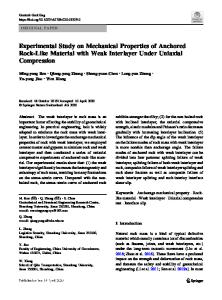Study on dynamic mechanical properties of phosphate rock through experimental tests and mesoscale simulation
- PDF / 2,179,778 Bytes
- 10 Pages / 595.276 x 790.866 pts Page_size
- 22 Downloads / 377 Views
ORIGINAL PAPER
Study on dynamic mechanical properties of phosphate rock through experimental tests and mesoscale simulation Xiqi Liu 1 & Gang Wang 1,2 & Tingting Liu 2 & Manqing Lin 3 & Hongxia Lei 4 & Abhay Kumar Mandal 1,2 Received: 14 May 2020 / Accepted: 2 September 2020 / Published online: 17 September 2020 # Saudi Society for Geosciences 2020
Abstract Dynamic characteristics of rock masses are an important part of the safety and stability analysis in rock mass engineering. The split Hopkinson pressure bar (SHPB) tests on the phosphate rock in Yichang are conducted, combined with the Split-desktop digital image method and mesoscopic discrete element method (DEM). Both macroscopic and mesoscopic characteristics of the phosphate rock have been studied from such perspectives as stress and strain, fractal characteristics of fragment size, and the spatial and temporal evolution of cracks. The research results show that the dynamic strength of the phosphate rock presents obvious strain rate effect, but the dynamic elasticity modulus is not so sensitive to the strain rate. There is a great correlation between the failure degree of rock specimens and the strain rate. The fractal characteristics of specimen fragments can be used to quantitatively evaluate the rock failure degree under impact loading. According to the characteristics of crack propagation, the rock failure process under the impact can be divided into four stages, namely the elastic crack-free stage, the crack initiation stage, the rapid crack growth stage, and the slow crack development stage. Moreover, with the increase of impact loading, micro-cracks are activated in large quantities. The specimens gradually change from the local damage mode to the axial splitting failure mode and to the crushing failure mode, and in this process, the number of tensile cracks takes an absolute advantage compared with the number of shear cracks. Keywords Rock dynamics . Phosphate rock . Split Hopkinson pressure bar . Fractal dimension . Mesoscopic particle flow discrete element
Abbreviations AE Acoustic emission CT Computed tomography D Fractal dimension DEM Discrete element method DIF Dynamic increase factor Responsible Editor: Zeynal Abiddin Erguler * Gang Wang [email protected] 1
School of Civil Engineering and Architecture, Wuhan University of Technology, Wuhan 430070, Hubei, China
2
Hubei Key Laboratory of Roadway Bridge and Structure Engineering, Wuhan University of Technology, Wuhan 430070, Hubei, China
3
School of Resources and Safety Engineering, Wuhan Institute of Technology, Wuhan 430070, Hubei, China
4
School of Architecture Environment, Ningxia Institute of Science and Technology, Shizuishan 753000, Ningxia, China
DFN PFC SEM SHPB a b A β Fn F′n Fs F′s I J Mb Ms N
Discrete fracture net Particle flow code Scanning electron microscopy Split Hopkinson pressure bar The length of fragment The width of fragment The cross-sectional area of the contact The contributing factor of the moment The real-time normal force on the contact Compressive stre
Data Loading...











